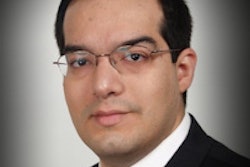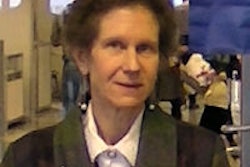
Radiology is undergoing a major shift in how it is practiced. In this rapidly changing healthcare environment, radiologists need to closely watch the emerging trends that are influencing their field, according to a presentation by Dr. Lawrence Muroff at the AHRA 2012 meeting in Orlando, FL.
 Dr. Lawrence Muroff, CEO and president of Imaging Consultants.
Dr. Lawrence Muroff, CEO and president of Imaging Consultants.
"Radiology is being forced to confront nontraditional issues, protect against aggressive competition, and cope with practice-threatening trends," Muroff said. "This is not the time for 'business as usual.' In the past it took work to fail. Now, it will take work to succeed."
In his presentation, Muroff discussed eight trends that have already begun and will continue to influence the practice of radiology.
Eight to watch
1. Declining reimbursement
The Deficit Reduction Act (DRA) of 2005 wasn't the end of reimbursement pressures; rather, it was just the beginning, Muroff said. Going forward, radiology will shoulder more than its share of the pain from reimbursement cuts.
Factors such as further increases in utilization rate calculations and cuts for imaging of contiguous body parts, consolidation of interventional radiology and CT codes, insurers adopting Medicare payment rates, and the failure to fix the sustainable growth rate (SGR) formula will continue to affect the downward trend.
2. Unrealistic focus on productivity, i.e., RVU output
To compensate for declining reimbursement rates, radiologists have increased their output as measured by relative value units (RVUs), Muroff said. But this focus trivializes key activities in a department, such as practice-building, consulting, and service. In addition, PACS has made radiologists even more remote, eroding clinical relationships.
"This combination of pressures has made radiologists more interchangeable and has contributed to the commoditization of the specialty," he said. "It's already difficult to get radiologists to attend conferences, consult with referring physicians, serve on hospital committees, and teach technologists."
How does this bode for the future? Hospitals will continue to become less attached to their radiologists, support for current radiology groups from referring physicians will be weaker, and there will be more turnover, Muroff said.
3. Washington's focus on family practitioners
It may seem like this is a fairly harmless trend, but it isn't, Muroff said. The U.S. Centers for Medicare and Medicaid Services (CMS) sees physician reimbursement as a zero-sum game: If one specialty gets more, another gets less.
"The perception in Washington is that family practitioners are underpaid and overworked, while the perception of radiologists is the exact opposite," he said. "Like it or not, radiologists have an image problem."
The answer to the image problem isn't to focus even more on productivity, but for radiologists to make themselves more accessible and service-oriented, according to Muroff.
4. The influx of nonphysician professionals
Radiologist assistants (RAs), radiology practitioner assistants (RPAs), physician assistants, and nurse practitioners will all play greater roles in radiology practices in the coming years. In many practices, they will replace the need for new radiologists, thus further tightening the job market, Muroff said. The net result is that fewer jobs will be available for residents and fellows coming out of training.
5. The cultural outlook of the Millennial Generation
Traditionally, radiologists have sought either more money or more time off. But the up-and-coming generation of young radiologists, the so-called "Millennials," want both, Muroff said. Does this outlook debilitate a radiology group's pride of ownership?
"If we don't make the time to build our practices, our turf will be eroded, our competitors will become more aggressive, and our power with payors and hospital administrators will diminish," he said. "Radiologists with an unrealistic sense of entitlement are less likely to work with their technical counterparts, and relationships tend to be ones of inequality -- if they exist at all."
6. Turf battles
More turf battles are on the horizon, according to Muroff, not only from cardiologists and orthopedists, but also from oncologists, gastroenterologists, obstetricians and gynecologists, vascular surgeons, and urologists.
"Why should radiologists believe that other specialists won't try to emulate the success of the cardiologists and the vascular surgeons?" Muroff asked. "It's a slippery slope, and just because we've been 'lucky so far' doesn't mean that we'll be lucky forever."
7. Hospital administrators demanding more
Why are hospitals getting more demanding? Because they're tired of hearing complaints from referring physicians; they want more control -- more hours, more physicians; they don't like competing with groups; they want to own a radiology group's practice-integrated model; and they often don't believe that the group can provide the needed subspecialty expertise that larger groups (and national radiology companies) offer, Muroff said.
"Most exits from hospitals are initiated by the hospital, not by the radiology group," he said. "Radiology is a service specialty. Provide the service and your contract will be far more secure."
8. Competition from academia
Cash-starved academic departments will be forced to compete in the private sector for specialty reads, teleradiology coverage, or even entire hospital contracts, Muroff said. Private practice does not have a lock on hospital contracts anymore.
"The traditional picture of an academic -- making less income, but serving the greater good -- has eroded over the past several years. With a few notable exceptions, it is no longer a sustainable situation," he said. "If there isn't collaboration [between private practice and academia], there will be competition. We're just starting to see competition from academia, and these efforts will only intensify."
The 'easy' issues?
These eight trends are just the "easy" issues, according to Muroff: Radiology still faces the threat of commoditization and outsourcing, corporatization, "retail medicine," and alternative payment mechanisms such as bundled payments and accountable care organizations (ACOs).
"Watch out for spot-market trading for imaging studies in 2015," Muroff said. "If relationships don't count and imaging is a commodity, why should Wall Street treat it differently from any other commodity? Combine this with a possible lifting of the Medicare ban of payments for overseas reads, and you have plummeting fees."
So what's the bottom line for 2015 -- and probably sooner? Shift your practice paradigm -- stat -- as things are going to be far more difficult than they've been in the past decade.
"In the old days, all radiologists wanted was to get their slice of the pie," he said. "Now they have to understand that the pie is going to be smaller, so to stay the same, they will have to get a bit of someone else's piece. If they want to grow, they may have to develop a different type of pie."




















